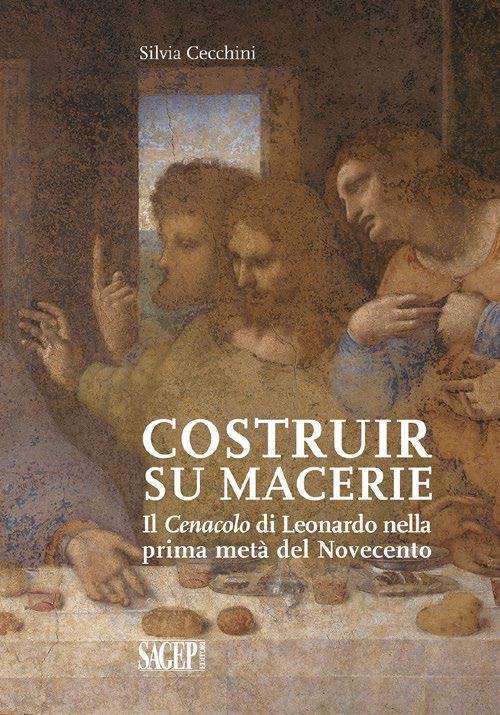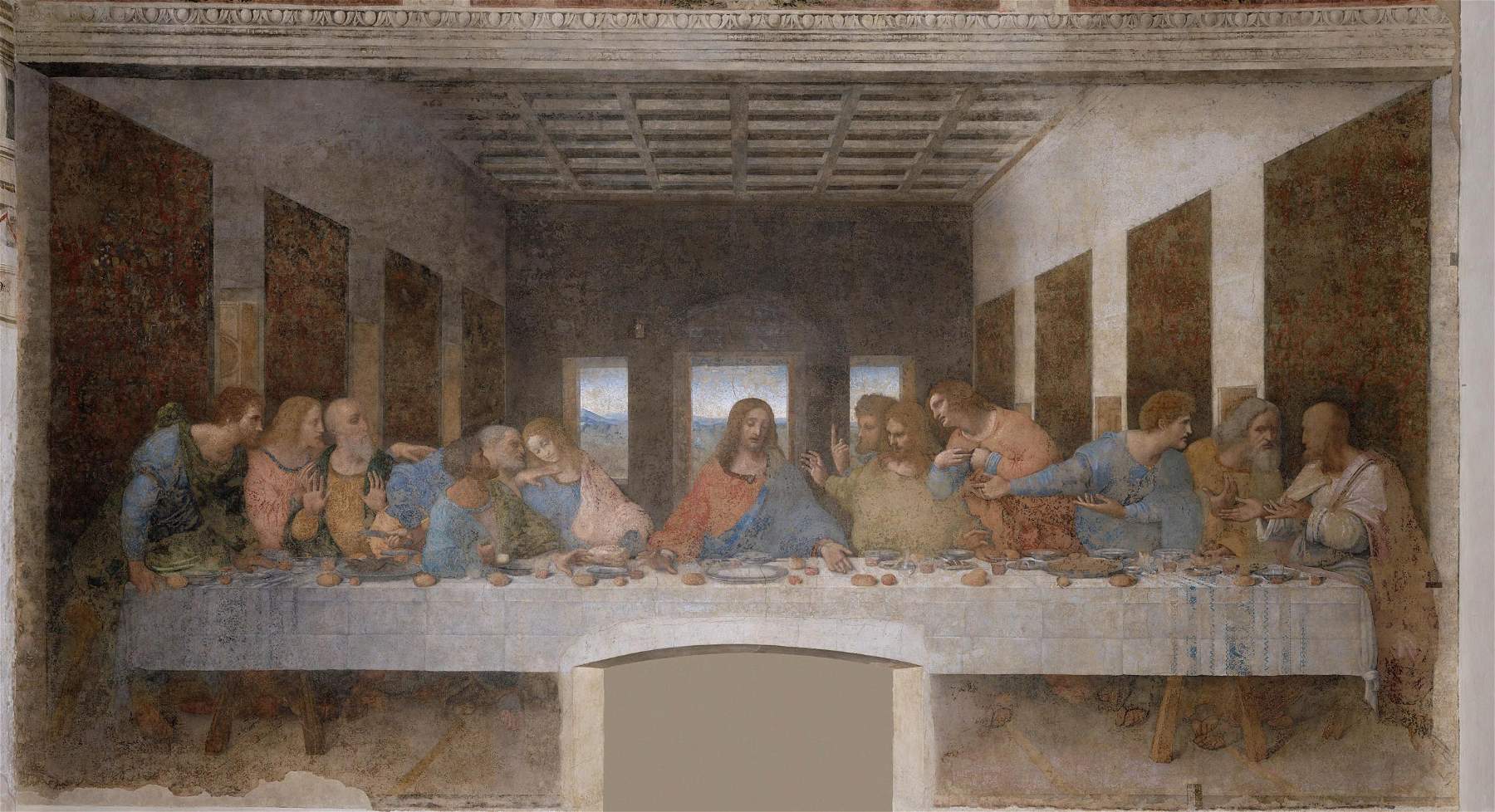Impeccable narrative, that of the restoration of Leonardo’s Last Supper, which Silvia Cecchini has published in the 333 pages, a fateful number, of her Building on Rubble, the same number of pages as a much-talked-about book that came out a few years ago on the restoration of Michelangelo’s Moses. Refined quotations, writing in excellent Italian with excerpts from texts in other languages, impeccable iconographic apparatus, and so on. A fine book that will certainly bring the Author a tenure-track professorship in restoration obtained with merit, so not one of those won by a Tar ruling as happens in Italy, as in some Banana Republics and not many other places in the world.
That said, Cecchini’s book, as it is structured, appears very interesting. Certainly for all the above, but also for a reason, I think, quite unique. Indeed, the author seems in her book to distance herself from restoration as a technical discipline by judging it to be a finished affair. Beginning with the title of the volume which is not, as one might think, a quotation from a romantic verse between Manzoni (“Dagli atrii muscosi, dai Fori cadenti”...) or Foscolo (“Rapían gli amici una favilla al Sole”...), but comes from a song by Francesco Guccini. A title that echoes such as that of the volume on the German novel in the 1950s published a decade ago by Maurizio Pirro, I imagine yet another of her friends she relentlessly mentions by the hundreds in the book. But returning to Cecchini’s having shifted a conspicuous part of her work on the restoration of the Upper Room to cultural history, it must be said that the attempt was accomplished with a mixture of admirable intelligence, erudition and expertise. I mention only, broadly, his openness to the Germanic world between psychoanalysis, philosophy, art history: Freud, Simmel, Hoerth, Burckhardt and whatnot. And I also emphasize her moving towards Cinema. Ä–jzenštejn, for example, whose admiration for Leonardo and his interest in the “montage” of a film about the “Last Supper” made in 1934. by one of his brilliant students, Constantine Pepinashvili, she recalls.
But it is with a long reflection on a text by Walter Benjamin that Cecchini makes a resolute entry into cultural history. Indeed, he quotes a passage from the German philosopher’s writings in which the latter asserted that in 1927 Abel Gance had seen the cinema as the instrument for a future resurrection of the dead, Shakespeare, Rembrandt, Beethoven and so on; concluding, again Benjamin, that Gance was thus inviting the liquidation of the traditional value of cultural heritage. An unusual quotation, as and indeed is the whole book. But already a century earlier Hegel had spoken, not of the liquidation of the traditional value of cultural inheritance, but directly of the end of history. A theme to which Alexandre Kojève had given definitive shape in the legendary lectures on the Hegelian Phenomenology of Spirit he delivered between 1933 and 1939 at the École pratique des Hautes Études in Paris.

Nor is this why Cecchini in her book does not talk about restoration. On the contrary, starting with the Last Supper, she writes a concise, eccentric and interesting history of restoration. For the earliest interventions, she takes up the unsurpassed four volumes of Vinci published in 1810 by Giuseppe Bossi, the same ones that Skira meritoriously reprinted a few years ago, and then goes on to recount the much that has happened since. It stops, however, at 1977, when Pinin Brambilla began his 20-year restoration of the Last Supper. Which is regrettable because Brambilla, thanks in part to the work direction of Carlo Bertelli and the Central Institute for Restoration (Icr) then headed by Urbani, conducted on the Cenacolo one of the most aesthetically educated and conservatively intelligent interventions of the entire twentieth century.
I repeat, a special history of restoration starting with the Last Supper, the one written by Cecchini, which begins, saying it very briefly, with Lombard restorers-painters such as Molteni, Pellicioli or Della Rotta, to name only the best known-who nevertheless used to clean the paintings the very aggressive caustic soda in rivers, as Cecchini may not know, but as it is instead useful to remember. Restorers who in the 1930s worked with a great superintendent, Ettore Modigliani, who was removed from Cenacolo because of the infamous racial laws and was succeeded by Guglielmo Pacchioni. Then the story of the bombing of La Scala, the Sala delle Cariatidi in the Royal Palace or the Gallery during World War II (missing, however, is the Basilica of Sant’Ambrogio on whose restoration Davide Borsa has written extensively) and their rebirth. And again, in a long chapter Cecchini recounts the great merits had by another superintendent, Fernanda Wittgens, a collaborator in the 1930s of Modigliani and an unjustly little-known figure despite having played a decisive part in the rebirth of Milan after the end of the war. And the author also recalls the strained relations between Brandi, i.e. the Icr, and Longhi, those that would leave a shadow for decades not only on restoration but also on the action of protection in Italy, favoring the formation of its current and increasingly serious cultural backwardness. And here I close my review of Cecchini’s fine book with two general notes.
One of the merits of Costruir su macerie is the very rich presence of figures and news items eccentric to the Upper Room for their extension not only to the history of culture, but also to Milanese and Italian political and civil history between fascism and anti-fascism. But the hundreds and hundreds of disparate facts and names that the author cites disorient. They thus become a critical point of the book because they are, at least in my opinion, too many. An excess of names, from Sartre, to Togliatti, Walt Whitman, Vittorini, Henry Miller, Banfi, Saitta, Albe Steiner, Fortini, San Vittore Prison, and even Walt Disney, which is also reflected in the general bibliography of more than four hundred titles, of which some are fundamental, many average last, and many directly useless because they are so mediocre. In short, a confusion that inevitably brings to mind a famous dictum of Talleyrand: "Tout ce qui est excessif c’est sans importance."
Another critical point is where cultural history takes Cecchini’s hand and makes her write inaccurate things about the very serious thing that is planned conservation, which everyone talks about but no one really knows what it is, but getting lavishly funded to implement it by a Ministry increasingly unable to distinguish the wheat from the chaff. In our case saying it, Cecchini, the result of the discussions of the early 1950s about the Last Supper and claiming it was born out of Urbani’s desire “to open a path that at least quantitatively reduces the ’historical shadow’ that Brandian (and Crocean) philological restorations leave on the works.” This is because (I say in a big way), following the dictate between historicism and Crucian aesthetics, repainting and whatever other non-original manipulation is removed from the works, leaving in view as such those gaps that were previously “patched” with retouching. So that the formal continuity of the original figurative text is deconstructed, thus bringing it closer to the formlessness of abstract art, thus to the taste of our time.

Things, however, are not like that. Indeed, planned conservation has nothing to do with “historical shadows.” It is in fact a “technique” (Heidegger) that was born when the flood of Florence on November 4, 1966 dramatically demonstrated how the formidable socio-economic change that took place in Italy after World War II had quickly produced a serious environmental issue in the country. The one that attacked the artistic heritage in its totality, thus overcoming at a stroke any problem of the Brandian critical-aesthetic restoration of individual works, including its “historical shadow,” instead forcing the superintendencies to deal with the real problem that has the protection in Italy. How to safeguard the feature that makes our historical and artistic heritage unique in the world. Its indissolubility from the environment in which it has endlessly stratified over the millennia. What the Icr immediately realizes is that it honors its task under the then-still-existing Law 1240/39 as a body charged with “carrying out scientific research aimed at perfecting and unifying its methods [and] studying the technical means for the best conservation of the national historical and artistic heritage.” What it does by fine-tuning a methodological organization, that is, a “technique” (Heidegger), with which to be able to preventively and programmatically conserve the artistic heritage in its totality and in the relationship of that totality to the totality of the environment.
The technique that is “programmed conservation.” That is, the technique that had its first - and so far only - application between 1966 and 1967 in the Boboli Lemon House made by the Institute of Technical Physics of the University of Rome suitable to be able to operate the Icr a very slow and programmed dehumidification of the boards flooded by the Arno River overflow. A restoration carried out without touching the works, but simply preventing the wood of the boards, shrinking too quickly, from causing the paintings’ pictorial film to fall to the ground. Thus overcoming at a stroke the solution that the Florentine superintendencies wanted to implement of detaching the film of the paintings from the wooden support and gluing it on a new polyester resin support, that is, “transporting” the boards. This was a handcrafted intervention that was seriously wrong in terms of conservation and those of artistic techniques.
Finally, to thank Cecchini for the gift she has given us with this volume of hers, I leave her with an anecdote for the book she will make on the history of the Cenacle after 1977. I make a premise. Giovanni Urbani considered Giovanni Spadolini and Giulio Carlo Argan to be the major smiths of the enormous cultural backwardness of conservation action in Italy. The Florentine journalist for founding in 1975 a Ministry of Cultural Heritage that repeated such and such the model of the General Directorate of Antiquities and Fine Arts founded a century earlier, in 1875, thus founding a Ministry without any prospect of innovation and development. The second, the Piedmontese art historian, for stubbornly keeping alive the protection law 1089, that is, a law designed for the archaic Fascist Italy of 1939 from which is absent any indication or even a mere hint of other possible ways of exercising protection in addition to that of notifications, constraints and whatever else measures only in the negative. Tools that are certainly necessary, but only when they are applied in function of a very specific conservative or evaluative purpose to be achieved in times and ways defined on a case-by-case basis. And here is the anecdote.
Early one morning I was in Urbani’s office at Icr. The phone rings. It is Argan asking for the reasons for the delay in proceeding with the restoration of the Last Supper. Urbani explains to him the great difficulties posed by that intervention. Argan retorts, “Maybe you have to do more refined chemical investigations.” And Urbani: “Look professor, if we did the investigations you are talking about, we would find hundreds of substances, glues, eggs, oils, resins, colors and so on applied at random in the hundred interventions that the painting has had over the centuries. That is, we would find a treatise on merceology.”
Warning: the translation into English of the original Italian article was created using automatic tools. We undertake to review all articles, but we do not guarantee the total absence of inaccuracies in the translation due to the program. You can find the original by clicking on the ITA button. If you find any mistake,please contact us.